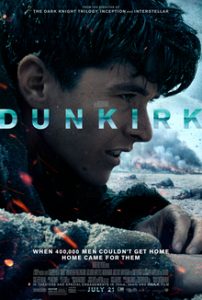By Eric Gasa

The battle of Dunkirk was hardly one to begin with. It was a miracle decided by hours, a near calamity in sight of home, a retreat that may have foolhardily saved the war. In history books, the evacuation of Dunkirk is little more than a tidy little paragraph; a footnote in time but its impact cannot be understated.
Operation Dynamo lasted little more than a week but saved the lives of over 400,000 Allied soldiers trapped on the shores of France. It’s within this brief and under-looked facet of the war that director Christopher Nolan expands a weeklong rescue into a telling, intimate statement of innocence, war, and humanity’s undying will to survive.
Dunkirk’s opening scenes are serene yet surreal. A group of British soldiers appear on a deathly quiet and abandoned French street. They skulk around looking for water, smokes, or any signs of hope or life. A light breeze carries a flurry of German pamphlets onto the soldiers.
A beleaguered grunt reads the scrap: “WE SURROUND YOU,” it says, “Surrender + Survive!”
Emboldened arrows point to the Allies last vestige of hope at Dunkirk like pitchforks. The year is 1940 and the German advance has the Allies’ backs up against the wall.
The silence is shattered by German machine guns that rip through the British squad. The first protagonist here is a boy named Tommy, and even though we don’t even know his name yet, we spend plenty of time watching him run for his life, helmet on head, hands white-knuckling the stock of his Enfield rifle.
His footsteps echo on the French cobblestone as he chases through the streets. Tommy suddenly finds himself at the edge of town and on the beach. He’s met with an eerie silence. Thousands of British infantrymen stand in single file along the shore like toy soldiers. They’re waiting for their ship home with the dead and wounded.
The prickly tick of a clock permeates the entirety of the movie like a time bomb about to explode. Its report puts the characters and viewers in suspense, watching the screen and skies for intrigue (and dive bombers).
Dunkirk especially succeeds at capturing the visceral feeling of war; flaming ships sink in idyllic seascapes like a Manet painting on fire; the metallic crack of gunfire; the sun glinting off the shiny steel skin of the Spitfires. You can thank photography director, Hoyte Van Hoytema for the exquisite shots.
Nolan takes the 22-mile length of the English Channel and stretches it into an eternity for sake of grandiosity and suspense. The ironic thing about Dunkirk was that British soldiers could practically see the cliffs of Dover from the French coastline, but without a ship to take them they might as well have been stranded on another planet. A disaster here would’ve spelled a demoralizing tragedy; to die on Dunkirk would be to drown in a shallow pool, snuffed out only inches away from safety.
But there are times where Dunkirk sags under Nolan’s unique directing style. Nine second dogfights are edited into twenty minute intervals, hightide takes forever to reach shore, and the most mundane of plot elements are stretched beyond recognition. The director divides two hours of screen time between six major characters resulting in some nonlinear interplay.
One scene ends with the Brits abandoning ship in the dead of night, then rewinds to a midday dogfight between British Spitfires and German BF-109s. The strange pacing is dizzying but not entirely too complicated though. Nolan did direct Inception after all and if one could follow that cycle they should have no problem with Dunkirk.
Though highly anticipated, Dunkirk may not be the Oscar-bait one would’ve hope for. The movie itself is solid, tense, and nerve-racking, but the sparse dialogue doesn’t lend itself to very many meaningful performances. Character development is set to a bare minimum; the only real personal story is centered on the small crew of a sailing vessel headed towards Dunkirk.
Harry Styles on the other hand does an excellent job of chewing on on some toast, shouting at comrades, and looking miserably into the camera while covered head to toe in oil. Tom Hardy can also be found as a British fighter pilot, but one would hardly even notice him from behind the oxygen mask and nonexistent dialogue. The screenplay on the other hand is fitting, authentic, and believable.
Though we already know how the story ends (and who won the war), Dunkirk closes with fresh hope in its eyes. The war in Europe would rage on for another five years but the fate of an Allied victory depended on the brave men fighting on the beaches, seas, and skies over France. Nolan makes a film that captures the cruciality of time and lethality of war. Sometimes mere minutes can change the course of history. Before winning the Good Fight there was the retreat that saved the world. There was Dunkirk.
